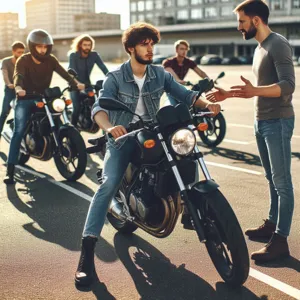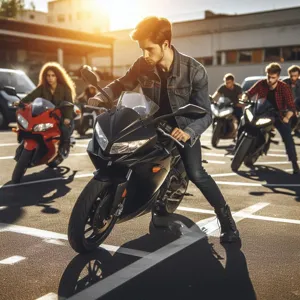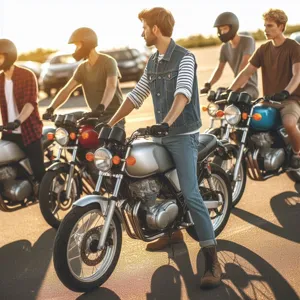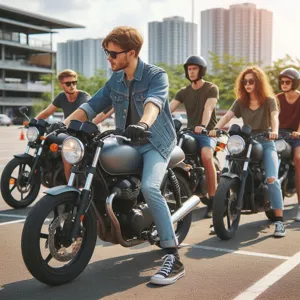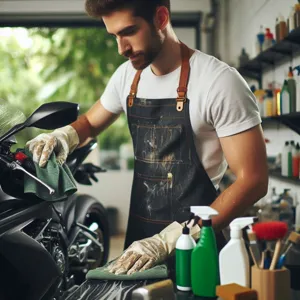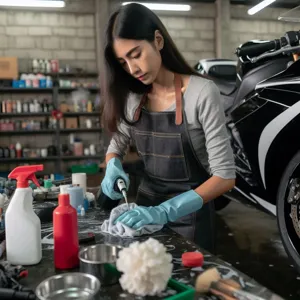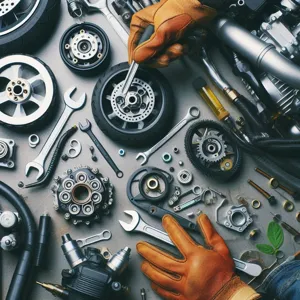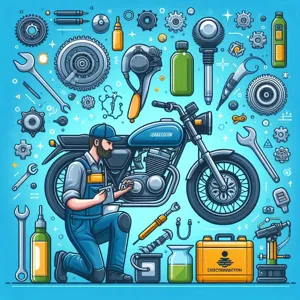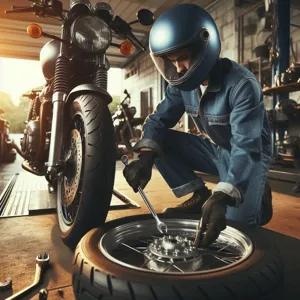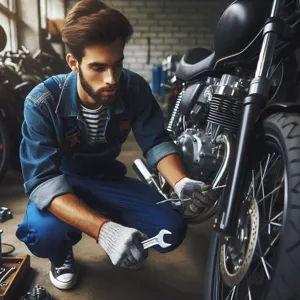Riding a motorbike can be one of the most exhilarating experiences, offering a unique sense of freedom and adventure that many enthusiasts cherish.
However, with this thrill comes a significant responsibility: ensuring your safety on the road. As the number of motorcyclists continues to rise, so does the need for awareness and caution. whether you’re a seasoned rider or a newcomer to the open road, understanding the essential tips for safe riding is crucial. In this post, we’ll explore ten indispensable motorbike riding tips designed to help you navigate the challenges of the road with confidence and skill. From mastering defensive riding techniques to choosing the right gear, these insights will empower you to enjoy your rides while minimizing risks, ensuring that every journey is both safe and memorable. So, rev up your engine and let’s dive into the world of safe motorbike riding!
1. Wear the Right Gear: Importance of Protective Clothing

When it comes to motorbike riding, your safety largely hinges on one critical factor: the gear you choose to wear. Protective clothing is not just an accessory; it’s an essential line of defense against the unpredictable nature of the road. The right gear can be the difference between a minor scrape and a serious injury in the event of an accident.
Investing in high-quality, durable clothing designed specifically for motorcyclists is paramount. This includes a sturdy helmet that meets safety standards, a well-fitted riding jacket made from abrasion-resistant materials, and protective pants that shield your legs. Look for gear that incorporates armor at key impact areas such as shoulders, elbows, and knees, offering an additional layer of protection.
But it’s not just about protection; comfort plays a significant role too. Riding can be a demanding activity, especially over long distances, so opting for breathable fabrics and ergonomic designs can help keep you comfortable and focused. Waterproof or weather-resistant gear is another smart choice, as it ensures you’re prepared for unexpected changes in the weather, allowing you to ride with confidence regardless of conditions.
In addition to traditional gear, consider investing in reflective clothing or accessories. Visibility is crucial, especially during low-light conditions. Bright colors and reflective strips can significantly increase your visibility to other drivers, reducing the risk of accidents.
Ultimately, wearing the right gear is an investment in your safety and well-being. It not only protects you from physical harm but also instills a sense of confidence as you navigate the open road. Remember, when you gear up, you’re not just preparing to ride; you’re equipping yourself for a safer, more enjoyable journey.
2. Always Wear a Helmet: Choosing the Right Type
When it comes to motorbike safety, the importance of wearing a helmet cannot be overstated. It’s not just a legal requirement in many places; it’s a crucial step in protecting your most valuable asset—your head. However, not all helmets are created equal, and choosing the right type is essential for ensuring maximum protection.
first and foremost, consider the different types of helmets available. full-face helmets provide the best protection as they cover the entire head, including the jaw and face, shielding you from potential impacts and debris. They often come with a visor, which can help shield your eyes from wind, rain, and UV rays. If you’re looking for versatility, modular helmets offer the convenience of being able to flip up the front section while still providing full-face protection when needed.
If your riding style leans towards off-road adventures, then a dirt bike helmet designed for rugged terrain is the way to go. These helmets are typically lighter with better ventilation but lack a face shield, so pairing them with goggles is essential for eye protection.
When selecting a helmet, ensure it fits snugly but comfortably. You should be able to wear it for extended periods without feeling pressure points. A properly fitting helmet will stay securely on your head in the event of an accident, providing the protection you need.
Don’t forget about safety certifications; look for helmets that meet DOT, ECE, or Snell standards. These certifications indicate that the helmet has undergone rigorous testing to ensure it can withstand impacts and provide adequate protection.
Lastly, consider additional features that enhance comfort and safety, such as moisture-wicking liners, ventilation systems, and reflective elements for increased visibility at night. Investing in a quality helmet tailored to your riding needs is not just about compliance; it’s about safeguarding your life on the road. Remember, your helmet is your first line of defense—choose wisely!
3. Check Your Bike Before Every Ride: Pre-Ride Safety Checklist

Before you hit the open road, taking a few moments to perform a thorough pre-ride check on your motorbike can make all the difference between a safe, enjoyable journey and a potentially hazardous one. This essential step is not just a routine; it’s your first line of defense against mechanical failures that could lead to accidents.
Begin with a visual inspection of the bike’s overall condition. Look for any signs of wear and tear, such as frayed cables, cracked fairings, or oil leaks, which can indicate underlying issues. Next, make sure your tires are in good shape; check for adequate tread depth and ensure they are properly inflated to the manufacturer’s recommended pressure. Remember, your tires are your only contact with the road, so their condition is critical for safe handling.
Once you’ve assessed the tires, move on to the brakes. Squeeze the brake levers and press the foot brake to ensure they engage smoothly and effectively. If you notice any sponginess or unusual noises, it may be time for a brake inspection. Don’t forget to check the fluid levels and inspect the brake pads for wear.
Next, take a moment to examine your lights and indicators. Turn on the headlights, brake lights, and turn signals to confirm they are functioning properly. Visibility is key, and ensuring that other drivers can see you is essential for your safety.
Finally, give your helmet and protective gear a once-over. Ensure your helmet is snug and secure, with no visible damage. Check that your gloves and riding jacket are in good condition and free of any tears or punctures.
By committing to this pre-ride safety checklist, you’re not just ensuring your bike is road-ready; you’re also fostering a responsible riding habit that prioritizes your safety and the safety of others on the road. Remember, a few extra minutes spent checking your bike can lead to a much more enjoyable and secure ride. Safe travels!
4. Stay Visible: Tips for Being Seen by Other Drivers
Staying visible on the road is one of the most crucial aspects of motorcycle safety. Unlike cars, motorbikes offer less bulk and can easily be overlooked by other drivers, making it essential for riders to take proactive steps to enhance their visibility. Here are some effective tips to ensure you stand out amid the hustle and bustle of traffic.
**Wear Bright and Reflective Gear:** Your choice of clothing can dramatically affect how noticeable you are to other motorists. Opt for bright, high-visibility colors like neon yellow, orange, or red. Additionally, gear with reflective strips can help catch the light from headlights, making you more visible at night or in low-light conditions. Remember, the more attention-grabbing your outfit, the more likely you are to be seen.
**Use Your Headlights Wisely:** Always ride with your headlights on, even during the day. Many motorcycles come equipped with daytime running lights, which enhance visibility. However, if your bike doesn’t have this feature, make it a habit to turn on your headlights whenever you ride. Bright and well-functioning lights not only illuminate your path but also signal your presence to other drivers.
**Position Yourself Strategically:** Positioning is key when it comes to being seen. Avoid riding in blind spots—whether it’s behind a large truck or next to another vehicle. Instead, try to occupy the lane where you can be easily spotted in mirrors and peripheral vision. Additionally, consider making lateral movements in your lane to attract attention, especially at intersections where visibility can be reduced.
**Use Turn Signals and Hand Signals:** Always signal your intentions clearly. Using your turn signals well in advance lets other drivers know your next move, reducing the risk of sudden lane changes or turns that could lead to accidents. Hand signals can also be effective, particularly in situations where your turn signals may be less visible.
**Make Eye Contact:** Whenever possible, try to make eye contact with drivers, especially at intersections. If you can see their faces, they can see you too. This simple act can help ensure that they are aware of your presence and intentions, potentially averting a collision.
By implementing these strategies, you can significantly enhance your visibility on the road, making it easier for other drivers to notice you and react accordingly. Remember, being seen is a vital part of staying safe while enjoying the freedom of the open road. Stay bright, stay alert, and ride smart!
5. Maintain a Safe Following Distance: Understanding Stopping Distance
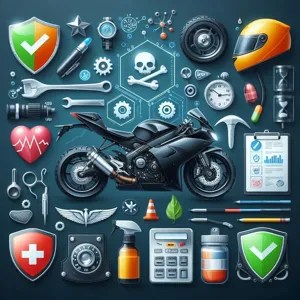
When it comes to riding a motorbike, maintaining a safe following distance is not just a good practice; it’s essential for your safety on the road. Unlike cars, motorcycles can stop more quickly, but they also have less stability, making it crucial to give yourself ample space between your bike and the vehicle in front of you. Understanding stopping distance is key to enhancing your reaction time and preventing accidents.
Stopping distance is the total distance your motorcycle travels from the moment you perceive a hazard to when you’ve come to a complete stop. This distance is influenced by several factors, including your speed, the condition of your tires, the road surface, and your own braking ability. A general rule of thumb is to maintain at least a two-second following distance under normal conditions. This means that if the vehicle in front of you passes a fixed point, you should count at least two seconds before you reach that same point. If road conditions are less than ideal—such as in rain, fog, or heavy traffic—it’s wise to increase this distance to three or even four seconds.
Being mindful of your braking distance can give you the cushion you need to react effectively to sudden stops or emergencies. It allows you the time to assess the situation, decide on a safe maneuver, and execute it without panic. Additionally, maintaining a safe following distance provides you with a clearer view of the road ahead, allowing you to anticipate potential hazards, such as potholes, debris, or erratic driving from other motorists.
Always remember that riding a motorcycle is a balance of skills, awareness, and caution. By respecting the space between you and the vehicle in front of you, you’re not only protecting yourself but also promoting a safer riding environment for everyone on the road. So next time you find yourself riding, take a moment to evaluate your following distance—and give yourself the time you need to stay safe.
6. Use Your Signals: Communication with Other Road Users
Using your signals is one of the most crucial aspects of safe motorbike riding, serving as a vital communication tool with other road users. Unlike cars, motorbikes are smaller and can easily get lost in the traffic, making it essential for you to convey your intentions clearly and effectively.
When you approach a turn, a lane change, or any maneuver that may affect those around you, always signal in advance. This simple action not only alerts drivers and pedestrians of your next move but also fosters a sense of predictability, which is vital for everyone sharing the road. Remember, visibility is key; make sure your signals are functioning properly and are bright enough to be seen, even during the day.
In addition to using your turn signals, consider incorporating hand signals into your riding routine. These old-school methods can be particularly effective, especially in situations where your electronic indicators might not be as noticeable. A simple left arm extended for a left turn or an upward hand for a right turn can make a significant difference in how other drivers perceive your intentions.
Moreover, it’s important to maintain eye contact with other road users whenever possible. This can help gauge their awareness of your presence and intentions. A nod or a wave can go a long way in fostering mutual respect and understanding on the road.
Ultimately, communication through signaling is not just about following traffic laws; it’s about ensuring your safety and the safety of others. By making your actions clear, you reduce the likelihood of miscommunication and potential accidents. So, as you ride, remember that every signal you make is a conversation with the road, and clarity is key to staying safe.
7. Be Aware of Road Conditions: Adjusting to Weather and Terrain
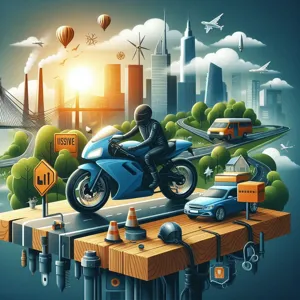
When it comes to motorbike riding, one of the most crucial skills you can develop is the ability to assess and adapt to changing road conditions. Weather and terrain can dramatically affect your ride, and staying vigilant about these factors can make all the difference in ensuring your safety.
Rain, for instance, can create slick surfaces that reduce traction, making it vital to slow down and increase your following distance. As water begins to mix with oil and debris on the road, the first few moments of rain can be particularly treacherous. If you find yourself caught in a downpour, remember to avoid sudden movements—gentle acceleration and braking can help maintain your balance.
On the other hand, sunny days can also pose their challenges. Glare from the sun can obstruct your vision and make it difficult to spot hazards. Wearing a tinted visor or polarized sunglasses can help mitigate this issue, allowing you to see the road clearly. Additionally, be cautious of heat waves, which can create distorted visual effects, making it tricky to judge distances and speeds.
When it comes to terrain, familiarity with your route can enhance your safety. Gravel, sand, or potholes can catch even the most experienced riders off guard. If you know you’ll be riding through areas with less stable surfaces, adjust your speed accordingly and remain alert for unexpected changes in the road.
In mountainous regions, be prepared for sudden weather changes and steep grades. Riding downhill requires a different approach; use engine braking to control your speed and avoid overheating your brakes.
Ultimately, being aware of and adapting to road conditions is not just about protecting yourself; it’s about enhancing your overall riding experience. By learning to read the road and adjust your riding style, you’ll find yourself more confident and in control, no matter what nature throws your way. So before you hit the asphalt, take a moment to assess the conditions and prepare yourself for a safe and enjoyable ride.
8. Ride Defensively: Anticipating the Actions of Other Drivers
Riding defensively is one of the most crucial skills a motorcyclist can master. Unlike cars, which provide a physical barrier between the driver and the surrounding environment, a motorbike leaves you exposed and vulnerable to the actions of other road users. To stay safe, you must adopt a proactive mindset, constantly anticipating the behavior of drivers around you.
Begin by understanding that not all drivers will see you, even if you’re in plain sight. Always assume that a vehicle may suddenly change lanes, make a turn without signaling, or pull out in front of you without looking. This awareness will help you maintain a safe distance from vehicles, giving you ample time to react if the unexpected occurs.
Keep your eyes moving and scan the road ahead for potential hazards. Look out for brake lights, turning signals, and any abrupt movements from vehicles that might indicate an impending lane change or stop. Your peripheral vision is just as important; be aware of everything happening around you, including pedestrians, cyclists, and other motorbikes.
Utilize the “space cushion” technique: maintain a safe distance from the vehicle in front of you, allowing for ample stopping time. This buffer can be a lifesaver in emergency situations. Additionally, try to position yourself in a lane where you have multiple escape routes in case a driver does not see you.
Finally, practice anticipating the actions of other drivers by considering their perspective. Are they distracted, in a rush, or maybe even inexperienced? This knowledge can guide your decisions on the road and help you make safer choices. Remember, defensive riding is not just about reacting to danger; it’s about avoiding it altogether. By anticipating the actions of others and riding with caution, you’re taking a significant step towards ensuring your safety and that of those around you.
9. Avoid Distractions: Staying Focused on the Road
In the fast-paced world of motorbike riding, distractions can be a rider’s worst enemy. With the wind in your hair and the open road ahead, it can be easy to let your mind wander or get sidetracked by the sights around you. However, maintaining unwavering focus is crucial for your safety and the safety of others on the road.
Distractions come in many forms, from the alluring landscape to notifications buzzing on your smartphone. Before you embark on your ride, take a moment to silence your phone and store it away. This small step can significantly reduce the temptation to check messages or scroll through social media while you’re on the move. Instead, consider using a hands-free device if you need to take a call, but remember that even conversations can take your attention away from the road.
Additionally, be mindful of your surroundings. Avoid getting lost in thought or daydreaming, as this can lead to delayed reactions to hazards or changes in traffic patterns. Train yourself to scan the road ahead continuously, keeping an eye out for potential obstacles such as potholes, debris, or erratic drivers.
Riding with a passenger can also introduce distractions. Ensure that both you and your passenger are aware of the importance of staying focused. Communicate beforehand about the need to minimize movement and conversation while riding, allowing you to concentrate on the task at hand.
Remember, riding a motorbike requires full engagement. By avoiding distractions and staying focused on the road, you not only protect yourself but also contribute to the safety of everyone around you. Keep your mind clear, your eyes on the road, and enjoy the ride with the peace of mind that you are prioritizing safety above all else.
10. Know Your Limits: Riding Within Your Skill Level
When it comes to motorbike riding, one of the most crucial yet often overlooked aspects of safety is understanding and respecting your own limits. Riding within your skill level is not just a matter of ego; it’s a fundamental principle that can significantly reduce your risk of accidents and enhance your overall riding experience.
Every rider is unique, with varying degrees of experience, comfort, and proficiency on two wheels. Whether you are a seasoned rider or a beginner, it’s vital to acknowledge where you stand in your skill development. If you’re still mastering the basics of handling your bike, taking on challenging terrains, high-speed maneuvers, or complex traffic situations can lead to dangerous scenarios.
Pay attention to how you feel in different riding conditions. If you find yourself feeling anxious or out of control, it may be a sign that you’re pushing your limits too far. Instead, focus on gradually building your skills through practice and training. Consider taking advanced riding courses that can help you become more proficient and confident on the road.
Additionally, ride with others who have a similar skill level. Group rides can be immensely enjoyable, but they can also escalate pressure to keep up with more experienced riders. Remember, it’s perfectly acceptable to ride at your own pace, even if that means lagging behind. Your safety is paramount, and there’s no shame in prioritizing your skills and comfort over bravado.
Always keep in mind that the road continually presents new challenges. Weather conditions, traffic, and unexpected obstacles can influence your riding experience, and being aware of these factors can help you make better decisions. By knowing your limits and sticking within them, you not only protect yourself but also contribute to a safer riding environment for everyone on the road. Stay sharp, stay smart, and most importantly, ride within your abilities. Your journey will be far more enjoyable and safe when you recognize what you can handle.
11. Practice Emergency Maneuvers: Handling Unexpected Situations
When it comes to motorbike riding, the ability to handle unexpected situations can mean the difference between a close call and a serious accident. Practicing emergency maneuvers is an essential skill that every rider should prioritize to enhance their safety on the road. These maneuvers include swerving, emergency braking, and cornering techniques, all of which can help you navigate sudden obstacles or changes in traffic conditions.
Start by finding a safe, open space where you can practice without the pressure of oncoming traffic. Set up cones or markers to simulate potential hazards you might encounter while riding, such as a car abruptly changing lanes or a pothole appearing out of nowhere. Begin with basic swerving exercises, focusing on quick and controlled movements. Lean your bike into the turn while maintaining a steady throttle, allowing for a smooth transition that keeps your balance intact.
Next, work on your emergency braking technique. Familiarize yourself with the feel of your brakes and practice applying them swiftly but smoothly to avoid skidding. This is especially crucial in situations where you need to stop suddenly, such as when a vehicle cuts you off or a pedestrian steps into the road. Remember, the key to effective braking is to use both the front and rear brakes in tandem, distributing the braking force evenly to maintain control.
Finally, practice cornering techniques that will help you navigate turns safely at varying speeds. Understanding the correct body positioning and throttle control while leaning into a corner can significantly reduce your risk of losing traction or control. As you practice these maneuvers, consider enrolling in an advanced riding course. These courses often provide valuable insights from experienced instructors, along with hands-on exercises designed to enhance your riding skills under pressure.
By incorporating emergency maneuvers into your routine, you’ll not only boost your confidence but also equip yourself with the skills necessary to respond effectively to the unexpected. Remember, the road can be unpredictable, but with practice and preparation, you can improve your ability to navigate through challenging situations, ensuring your safety and that of others on the road.
12. Stay Sober: The Dangers of Riding Under the Influence
Riding a motorbike is an exhilarating experience that offers a unique sense of freedom and adventure. However, this thrill comes with significant responsibilities, particularly when it comes to your own safety and the safety of others on the road. One of the most critical tips for ensuring a safe ride is to **stay sober**. The dangers of riding under the influence cannot be overstated; alcohol and drugs impair judgment, slow reaction times, and diminish coordination—all essential skills for any motorcyclist.
When you’re behind the handlebars, even a small amount of alcohol can drastically affect your ability to process information. The blurred vision, reduced concentration, and delayed reflexes that come with intoxication can turn a routine ride into a life-threatening situation. According to statistics, a significant percentage of motorcycle accidents involve riders who have consumed alcohol, making sobriety not just a personal choice but a crucial safety measure.
Imagine navigating a busy intersection, where split-second decisions can mean the difference between safety and disaster. Under the influence, you may misjudge a turning vehicle, fail to react to sudden obstacles, or simply overlook a critical traffic signal. The consequences can be devastating—not only for you but also for your passengers and other road users.
To reinforce the importance of staying sober, consider establishing a pre-ride routine: assess your state of mind, commit to avoiding any substances that could impair your abilities, and think ahead about your plans for the evening. If you know you’ll be drinking, arrange for a designated driver or utilize rideshare services to get home safely.
Remember, riding a motorcycle is not just about enjoying the ride; it’s about prioritizing safety on every journey. By committing to sobriety, you’re not only protecting yourself but also contributing to a safer environment for everyone on the road. Stay vigilant, stay sober, and keep the thrill of motorcycling a safe and enjoyable experience.
13. Join a Riding Course: Enhancing Your Skills and Knowledge
Joining a riding course is one of the most effective ways to enhance your skills and knowledge as a motorcyclist. Whether you’re a seasoned rider or a novice just getting started, enrolling in a structured riding course can significantly improve your safety on the road. These courses are designed to teach you essential riding techniques, road safety rules, and emergency response strategies that are often overlooked in casual riding.
In a professional riding course, you’ll have the opportunity to learn from experienced instructors who can provide personalized feedback and guidance. They’ll introduce you to advanced riding techniques such as cornering, braking, and maneuvering in various weather conditions. Additionally, you’ll gain a deeper understanding of your motorcycle’s mechanics, helping you recognize and address potential issues before they become serious problems.
Beyond skill enhancement, riding courses also foster a sense of community among participants. You’ll ride alongside fellow enthusiasts who share your passion, allowing you to exchange tips and experiences. Many courses also offer the chance to connect with local motorcycle clubs and organizations, opening doors to group rides and events that can deepen your engagement with the motorcycling community.
Moreover, completing a recognized riding course often comes with the added benefit of insurance discounts. Many providers view riders who have undergone formal training as lower-risk, which can translate into significant savings on your premiums.
Ultimately, participating in a riding course is an investment in your safety and riding longevity. With the knowledge and skills gained, you’ll not only feel more confident on the road but also be better equipped to respond to unexpected situations, ensuring a safer and more enjoyable riding experience every time you hit the pavement.
14. Stay Informed: Understanding Local Traffic Laws
Understanding local traffic laws is not just a legal obligation; it’s a cornerstone of safe riding. Each city, state, or country may have unique regulations that govern motorbike operation, and being informed of these can significantly enhance your safety on the road. Familiarize yourself with the specific traffic rules in your area, including speed limits, lane usage, and any local ordinances that may apply to motorcyclists.
For instance, some regions may have specific helmet laws, while others might require additional safety gear. Understanding these requirements can help you avoid fines and keep you protected. Additionally, local traffic laws may dictate how you should navigate through intersections, handle roundabouts, or respond to emergency vehicles.
Moreover, staying informed about recent changes to traffic laws is crucial, as regulations can evolve based on new safety studies or community feedback. Subscribe to local motorbike associations or safety organizations that offer updates on traffic laws and safety tips. Engaging with fellow riders can also provide insights and experiences that help you remain vigilant.
By prioritizing knowledge of local traffic laws, you empower yourself to make informed decisions while riding. This not only enhances your safety but also promotes a culture of responsible riding within your community, ultimately making the roads safer for everyone.
15. Build a Community: The Importance of Riding with Others
Riding a motorbike can be an exhilarating experience, but it can also come with its fair share of risks. One of the most effective ways to enhance your safety on the road is to build a community and ride with others. There’s a unique camaraderie that forms among motorcyclists, and sharing the road with fellow riders can provide numerous benefits, both in terms of safety and enjoyment.
When you ride with others, you create a support system that can greatly enhance your awareness and response to potential hazards. Group riding fosters an environment where everyone looks out for one another, helping to spot dangers that may go unnoticed when you’re riding solo. Whether it’s a sudden obstacle in the road, a reckless driver, or a change in weather conditions, having companions to communicate with can significantly improve your chances of reacting appropriately and safely.
Additionally, riding with a group allows for the sharing of knowledge and experience. Seasoned riders can offer invaluable tips and insights, helping less experienced members improve their skills and confidence. Group rides often include discussions about maintenance, safety gear, and local riding laws, creating a learning opportunity that can benefit everyone involved. This shared knowledge not only promotes safer riding habits but also strengthens the bonds within the community.
Moreover, riding with others can make your experiences more enjoyable. The thrill of cruising down winding roads, the sense of adventure in exploring new destinations, and the joy of sharing these moments with fellow enthusiasts can transform a simple ride into a memorable journey. Group rides often encourage a sense of belonging and shared passion, making it easier to forge friendships that extend beyond the open road.
Don’t forget about the practical aspects, too. In the unfortunate event of a breakdown or an accident, having fellow riders nearby can be a lifesaver. They can assist you with immediate support, whether it’s helping you fix a flat tire or ensuring that you get back on the road safely. Additionally, the presence of a riding group can deter potentially dangerous behavior from other motorists, as drivers tend to be more cautious around groups of riders.
In conclusion, building a community and riding with others is not just about camaraderie; it’s about enhancing safety, sharing knowledge, and enriching your riding experience. So whether it’s joining a local motorcycle club, participating in group rides, or simply connecting with fellow riders online, make it a priority to embrace the power of community on your motorbike journeys. You’ll not only stay safer on the road but also create lasting memories with those who share your passion for riding.
As we conclude our exploration of the 10 essential motorbike riding tips for staying safe on the road, it’s clear that safety is paramount for every rider. By incorporating these tips into your daily riding routine—whether it’s wearing the right gear, mastering defensive riding techniques, or staying vigilant about road conditions—you can significantly reduce your risk and enhance your overall riding experience. Remember, being a responsible motorbike rider not only protects you but also ensures the safety of those around you. We hope these insights empower you to ride with confidence and peace of mind. So, gear up, hit the road, and enjoy the thrill of motorcycling while prioritizing your safety at every turn. Safe travels!

